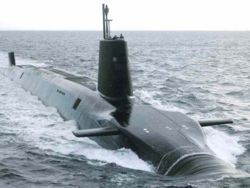Submarine
 From Conservapedia
From Conservapedia 
A submarine is a vehicle that travels under water (i.e. an underwater boat). The submarine was invented in the 17th century. Though it was originally designed for the purpose of exploration, its military benefits soon became clear. The first military submarine was the Turtle which was used by the Colonists during the American Revolution, although without success.
Contents
- 1 History
- 2 Power sources
- 3 United States Navy
- 3.1 Ohio-class submarine
- 4 See also
- 5 External links
History[edit]
The first submarine to successfully sink a ship was the Confederate vessel CSS Hunley which sank the USS Housatonic during the American Civil War on 17 February 1864 in Charleston Harbour. The Hunley never returned from the mission, sinking with the loss of all crew. It has recently been found and recovered.
The first submarine commissioned into the United States Navy was the USS Holland. She was commissioned on Columbus Day in 1900 and was subsequently designated SS 1.
Submarines played a significant role in both World Wars I and II, and to this day many nations have submarine fleets, varying from the large, highly trained nuclear fleets of the United States and the United Kingdom, to countries owning one Kilo class diesel submarine.


Seawolf class submarines have eight torpedo tubes and can hold up to 50 weapons in its torpedo room.
Power sources[edit]
Various different power sources have been used on submarines over the years. The Hunley was powered by its crew turning a crank which was connected to the propeller. Petrol engines have also been used, but they gave way to diesel engines. The petrol or diesel engine drives a generator, which charges a battery, and the battery supplies an electric motor which propels the submarine. The petrol or diesel engine can only be run when the submarine is on the surface, to recharge the battery.
Hydrogen peroxide was used in some German submarines during World War II. More recently nuclear power has been used. It should be noted it this context that the term "nuclear submarine" refers to a submarine that uses nuclear power for propulsion, not necessarily one which carries nuclear weapons.
[edit]
Today, the United States Navy operates 14 Ohio class SSBN's, 4 Ohio class SSGN's, 3 Seawolf class SSN's, approximately 40 Los Angeles Class SSN's, and 2 commissioned Virginia class SSN's.
- SSN is Ship, Submersible, Nuclear (powered)
- SSBN is Ship, Submersible, Ballistic (missile), Nuclear (powered)
- SSGN is Ship, Submersible, Guided (missile), Nuclear (powered)

The "N" refers to nuclear propulsion, not necessarily nuclear weapons. An SSBN is capable of being armed with nuclear missiles while an SSGN is designed to carry up to 154 Tomahawk cruise missiles. SSN's are capable of carrying Tomahawks, but only a very limited number of tubes. The SSGN has 8 tubes that can be reconfigured to support Special Operations Forces in a variety of roles.
Currently, the United States Navy maintains submarines bases in:
- Groton, CT
- Norfolk, VA
- Kingsbay, GA
- Banger, WA
- San Diego, CA
- Pearl Harbor, HA
- Guam
- At least for the meantime there is a submarine tender at the NSA (naval support activity) located in LaMadalena, Italy. An island off the coast of Sardinia.
Ohio-class submarine[edit]

.jpg)
According to the National Interest website: "The Ohio-class boats may be the most destructive weapon system created by humankind. Each of the 170-meter-long vessels can carry twenty-four Trident II submarine-launched ballistic missiles (SLBMs) which can be fired from underwater to strike at targets more than seven thousand miles away depending on the load."[2]
See also[edit]
- Naval warfare
- United States Navy
- Destroyer
- AE2
- USS Grunion (SS-216)
- K-129
- Nuclear target structures
External links[edit]
- The Silent Service (in color) - U.S. Navy WWII (video - The Story of U.S. Submarine Warfare in the Pacific During WWII)
Categories: [Nuclear Defense] [Military Strategies and Concepts] [Military] [Warships] [Submarines]
↧ Download as ZWI file | Last modified: 02/22/2023 16:32:37 | 109 views
☰ Source: https://www.conservapedia.com/Submarine | License: CC BY-SA 3.0
 ZWI signed:
ZWI signed: KSF
KSF